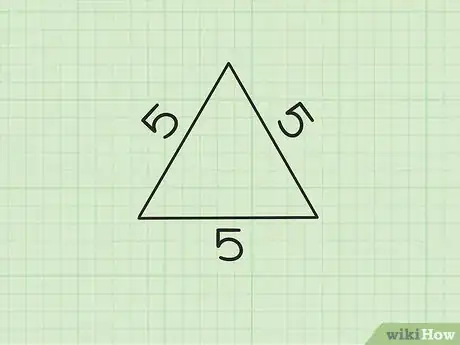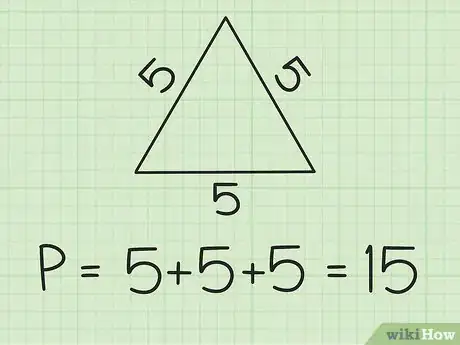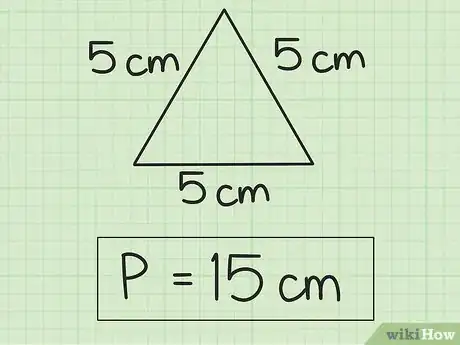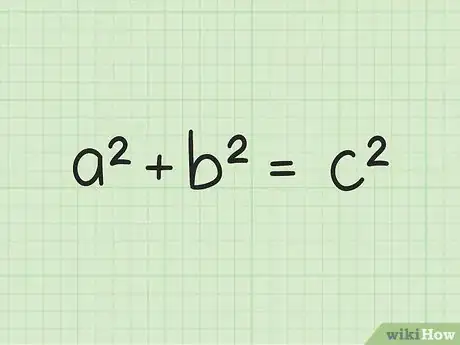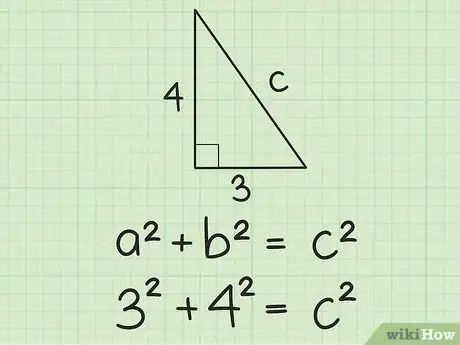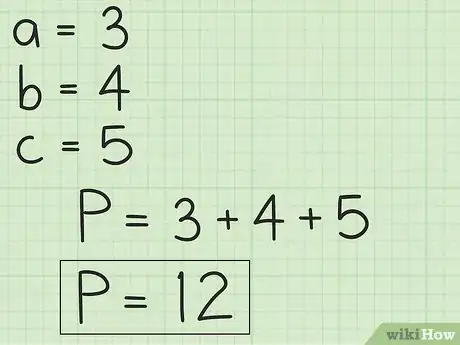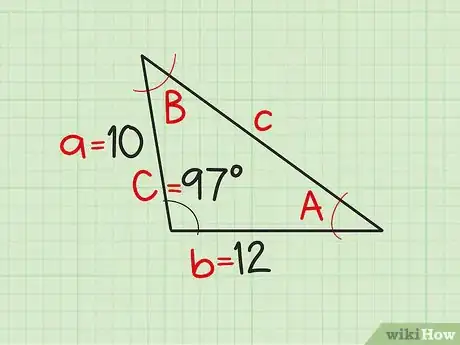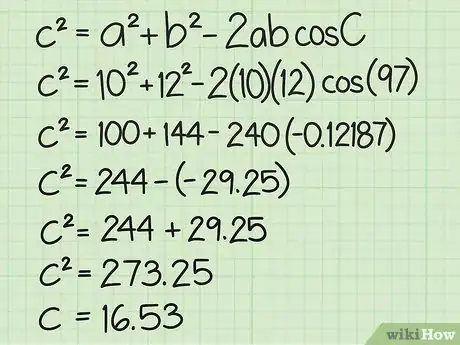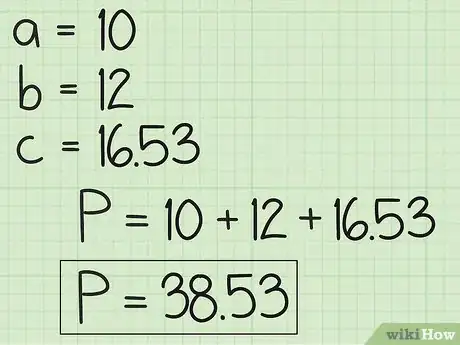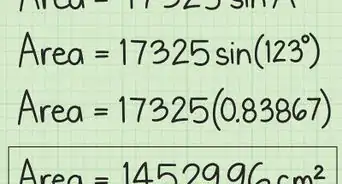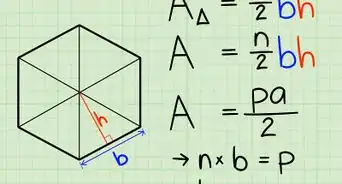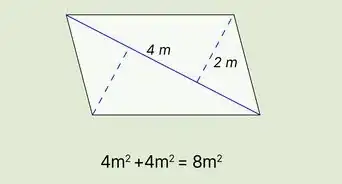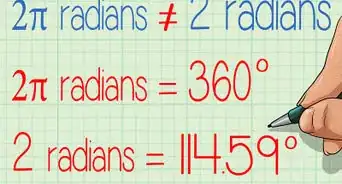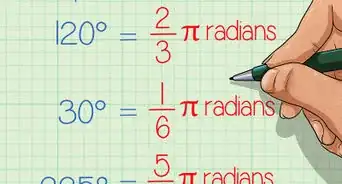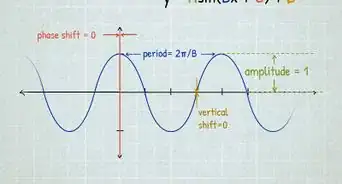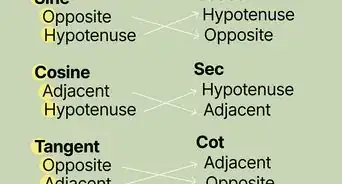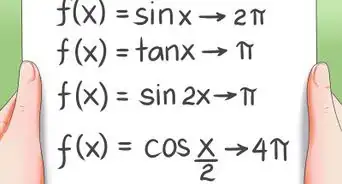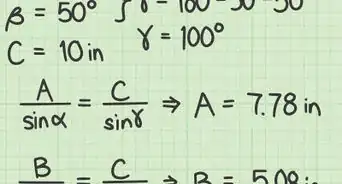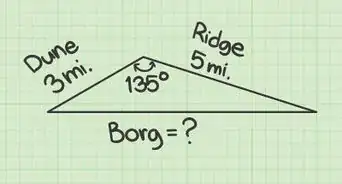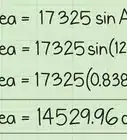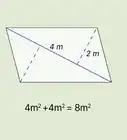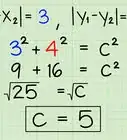This article was co-authored by Grace Imson, MA. Grace Imson is a math teacher with over 40 years of teaching experience. Grace is currently a math instructor at the City College of San Francisco and was previously in the Math Department at Saint Louis University. She has taught math at the elementary, middle, high school, and college levels. She has an MA in Education, specializing in Administration and Supervision from Saint Louis University.
There are 11 references cited in this article, which can be found at the bottom of the page.
This article has been viewed 1,716,007 times.
Finding the perimeter of a triangle means finding the distance around the triangle.[1] The simplest way to find the perimeter of a triangle is to add up the length of all of its sides, but if you don't know all of the side lengths you will need to calculate them first. This article will first teach you to find the perimeter of a triangle when you do know all three side lengths; this is the easiest and most common way. It will then teach you to find the perimeter of a right triangle when only two of the side lengths are known. Finally, it will teach you to find the perimeter of any triangle for which you know two side lengths and the angle measure between them (an "SAS Triangle"), using the Law of Cosines.
Steps
Finding the Perimeter When Three Side Lengths are Known
-
1Remember the formula for finding the perimeter of a triangle. For a triangle with sides a, b and c, the perimeter P is defined as: P = a + b + c.[2]
- What this formula means in simpler terms is that to find the perimeter of a triangle, you just add together the lengths of each of its 3 sides.
-
2Look at your triangle and determine the lengths of the three sides. In this example, the length of side a = 5, the length of side b = 5, and the length of side c = 5.
- This particular example is called an equilateral triangle, because all three sides are of equal length. But remember that the perimeter formula is the same for any kind of triangle.
Advertisement -
3Add the three side lengths together to find the perimeter. In this example, 5 + 5 + 5 = 15. Therefore, P = 15.
- In another example, where a = 4, b = 3, and c=5, the perimeter would be: P = 3 + 4 + 5, or 12.
-
4Remember to include the units in your final answer. If the sides of the triangle are measured in centimeters, then your answer should also be in centimeters. If the sides are measured in terms of a variable like x, your answer should also be in terms of x.[3]
- In this example, the side lengths are each 5cm, so the correct value for the perimeter is 15cm.
Finding the Perimeter of a Right Triangle When Two Sides are Known
-
1Remember what a right triangle is. A right triangle is a triangle that has one right (90 degree) angle. The side of the triangle opposite the right angle is always the longest side, and it is called the hypotenuse. Right triangles show up frequently on math tests, and fortunately there is a very handy formula for finding the length of unknown sides!
-
2Recall the Pythagorean Theorem. The Pythagorean Theorem tells us that for any right triangle with sides of length a and b, and hypotenuse of length c, a2 + b2 = c2.[4]
-
3Look at your triangle, and label the sides "a," "b," and "c". Remember that the longest side of the triangle is called the hypotenuse. It will be opposite the right angle and must be labeled c. Label the two shorter sides a and b. It doesn't really matter which is which, the math will turn out the same!
-
4Enter the side lengths that you know into the Pythagorean Theorem. Remember that a2 + b2 = c2. Substitute the side lengths in for the corresponding letters in the equation.[5]
- If, for example, you know that side a = 3 and side b = 4, then plug those values into the formula as follows: 32 + 42 = c2.
- If you know the length of side a = 6, and the hypotenuse c = 10, then you should set the equation up like so: 62 + b2 = 102.
-
5Solve the equation to find the missing side length. You will first need to square the known side lengths which means multiplying each value by itself (for example 32 = 3 * 3 = 9). If you are looking for the hypotenuse, simply add the two values together and find the square root of this number to find the length. If it is a side length you are missing, you must do a bit of easy subtraction, and then take the square root to get your side length.[6]
- In the first example, square the values in 32 + 42 = c2 and find that 25= c2. Then calculate the square root of 25 to find that c = 5.
- In the second example, square the values in 62 + b2 = 102 to find that 36 + b2 = 100. Subtract 36 from each side to find that b2 = 64, then take the square root of 64 to find that b = 8.
-
6Add up the lengths of the three side lengths to find the perimeter. Recall that the perimeter P = a + b + c. Now that you know the lengths of sides a, b and c, you simply need to add the lengths together to find the perimeter.[7]
- In our first example,P = 3 + 4 + 5, or 12.
- In our second example, P = 6 + 8 + 10, or 24.
Do you have the perimeter and are missing one side? Then you should subtract the sum of the two sides from the perimeter. This number equals the length of the missing side.
Finding the Perimeter of an SAS Triangle Using the Law of Cosines
-
1Learn the Law of Cosines. The Law of Cosines allows you to solve any triangle when you know two side lengths and measurement of the angle between them. It works on any triangle, and is a very useful formula. The Law of Cosines states that for any triangle with sides a, b, and c, with opposite angles A, B, and C: c2 = a2 + b2 - 2ab cos(C).[8] [9]
-
2Look at your triangle and assign variable letters to its components. The first side that you know should be labeled a, and the angle opposite it is A. The second side that you know should be labeled b; the angle opposite it is B. The angle that you know should be labeled C, and the third side, the one you need to solve in order to find the perimeter of the triangle, is side c.[10]
- For example, imagine a triangle with side lengths 10 and 12, and an angle between them of 97°. We will assign variables as follows: a = 10, b = 12, C = 97°.
-
3Plug your information into the equation and solve for side c. You will first need to find the squares of a and b, and add them together. Then find the cosine of C using the cos function on your calculator, or an online cosine calculator.[11] Multiply cos(C) by 2ab and subtract the product from the sum of a2 + b2. The result is c2. Find the square root of this value and you have the length of side c.[12] Using our example triangle:
- c2 = 102 + 122 - 2 × 10 × 12 × cos(97).
- c2 = 100 + 144 – (240 × -0.12187) (Round the cosine to 5 decimal places.)
- c2 = 244 – (-29.25)
- c2 = 244 + 29.25 (Carry the minus symbol through when cos(C) is negative!)
- c2 = 273.25
- c = 16.53
-
4Use side length c to find the perimeter of the triangle. Recall that Perimeter P = a + b + c, so all you need to do is add the length you just calculated for side c to the values you already had for a and b.
- In our example: 10 + 12 + 16.53 = 38.53, the perimeter of our triangle!
Triangle Perimeter Calculator, Practice Problems, and Answers
Community Q&A
-
QuestionCan you find the perimeter if only one side is given?
 wikiHow Staff EditorThis answer was written by one of our trained team of researchers who validated it for accuracy and comprehensiveness.
wikiHow Staff EditorThis answer was written by one of our trained team of researchers who validated it for accuracy and comprehensiveness.
Staff Answer wikiHow Staff EditorStaff AnswerIf you know only 1 side but all 3 angles, you can use the rule of sines to find the remaining sides, then calculate the perimeter. If you know 1 side and 1 angle, you won’t be able to find the perimeter unless you’re dealing with a right triangle. For right triangles, you know that 1 angle is always 90°, so if you know another angle, you can use the sum of angles (180°) to figure out the third one. From there, you can use the laws of sine and cosine to figure out the other sides.
wikiHow Staff EditorStaff AnswerIf you know only 1 side but all 3 angles, you can use the rule of sines to find the remaining sides, then calculate the perimeter. If you know 1 side and 1 angle, you won’t be able to find the perimeter unless you’re dealing with a right triangle. For right triangles, you know that 1 angle is always 90°, so if you know another angle, you can use the sum of angles (180°) to figure out the third one. From there, you can use the laws of sine and cosine to figure out the other sides. -
QuestionHow can you find the perimeter of a triangle if one side is missing?
 wikiHow Staff EditorThis answer was written by one of our trained team of researchers who validated it for accuracy and comprehensiveness.
wikiHow Staff EditorThis answer was written by one of our trained team of researchers who validated it for accuracy and comprehensiveness.
Staff Answer wikiHow Staff EditorStaff AnswerIf it’s a right triangle, you can use the Pythagorean theorem (a2 + b2 = c2) to find the length of the missing side. From there, you can easily calculate the perimeter. For other types of triangles, you can use the law of cosines to find the perimeter if you know 2 sides and at least 1 of the angles.
wikiHow Staff EditorStaff AnswerIf it’s a right triangle, you can use the Pythagorean theorem (a2 + b2 = c2) to find the length of the missing side. From there, you can easily calculate the perimeter. For other types of triangles, you can use the law of cosines to find the perimeter if you know 2 sides and at least 1 of the angles. -
QuestionHow can you find the missing side of a triangle given the perimeter?
 wikiHow Staff EditorThis answer was written by one of our trained team of researchers who validated it for accuracy and comprehensiveness.
wikiHow Staff EditorThis answer was written by one of our trained team of researchers who validated it for accuracy and comprehensiveness.
Staff Answer wikiHow Staff EditorStaff AnswerSince the perimeter is the sum of the lengths of all sides, you can solve for the missing side by subtracting the lengths of the other 2 sides from the perimeter.
wikiHow Staff EditorStaff AnswerSince the perimeter is the sum of the lengths of all sides, you can solve for the missing side by subtracting the lengths of the other 2 sides from the perimeter.
References
- ↑ http://www.mathsisfun.com/geometry/perimeter.html
- ↑ https://www.cuemath.com/measurement/perimeter-of-a-triangle/
- ↑ https://www.omnicalculator.com/math/triangle-perimeter
- ↑ https://www.varsitytutors.com/basic_geometry-help/how-to-find-the-perimeter-of-a-right-triangle
- ↑ https://sciencing.com/perimeter-right-triangle-6196682.html
- ↑ https://sciencing.com/perimeter-right-triangle-6196682.html
- ↑ https://www.cuemath.com/measurement/perimeter-of-right-angled-triangle/
- ↑ https://www.mathsisfun.com/algebra/trig-cosine-law.html
- ↑ http://www.cimt.org.uk/projects/mepres/step-up/sect4/index.htm
About This Article
To find the perimeter of a triangle, use the formula perimeter = a + b + c, where a, b, and c are the lengths of the sides of the triangle. For example, if the length of each side of the triangle is 5, you would just add 5 + 5 + 5 and get 15. Therefore, the perimeter of the triangle is 15. If you only know the length of 2 of the triangle’s sides, you can still find the perimeter if it’s a right triangle, which means the triangle has one 90-degree angle. Just use the Pythagorean theorem, which is a^2+ b^2 = c^2, where a and b are the lengths of the known sides and c is the length of the unknown hypotenuse. For example, if the length of the known sides are 3 and 4, you would just add 3^2+ 4^2, or 9 + 16, and get 25. Then, you would take the square root of 25 to find c, which is 5. Therefore, the length of the unknown side is 5. Finally, add all of the side lengths together to find the perimeter. In this case you would add 3 + 4 + 5 and get 12. Therefore, the perimeter of the triangle is 12. If you want to learn how to solve the perimeter of your triangle if you only know 2 sides and an angle, keep reading the article!

